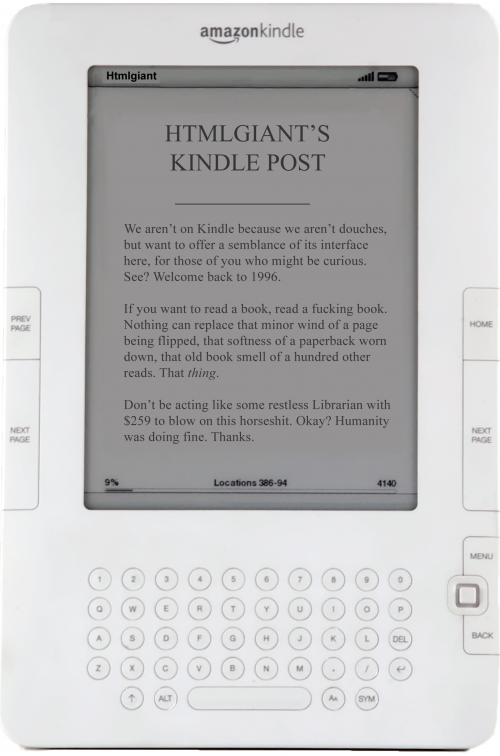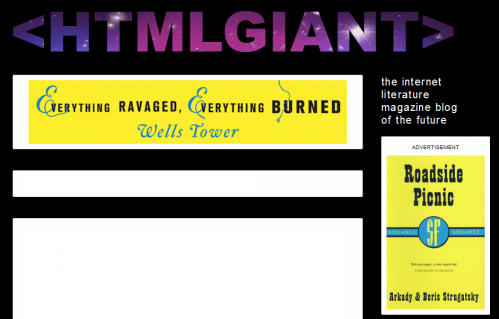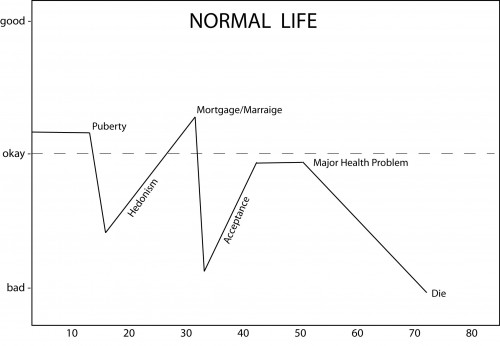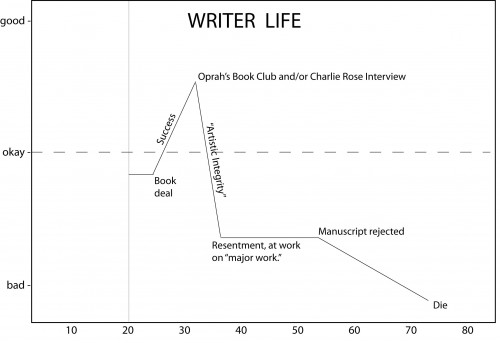SarcMark, it’s awesome

Sarcasm, Inc. has patented a “SarcMark,” a punctuation mark which looks like a recoiled question mark, to signify sarcasm. Of their 3rd “Core Belief,” they proclaim “For centuries, questions and exclamations have had their own punctuation marks. It’s time that sarcasm is treated equally!” Wow, that’s pretty cool how they used that antiquated exclamation mark![]() . Yah, these guys are not only cutting-edge grammarians, but great entrepreneurs
. Yah, these guys are not only cutting-edge grammarians, but great entrepreneurs![]() .
.
Isn’t it funny how this sentence raises a question without a question mark. Or how “the decapitated man still flinched” is arguably more effective than “the decapitated man still flinched!” Intent, when implicit, is a sharper, smoother cut. The author’s story lies not on the page, but in the reader’s mind.
Christ, I just wish I could download the SarcMark, because without it, without that fucking awesome SarcMark I cannot be sarcastic! I can only be excited — with or without any marks signifying those feelings — so, so excited.
We’ve been linked at The New Yorker, thanks to either Lucy Tang, Brandon Scott Gorrell, Tao Lin, or you +200 emotional people.
Attitudinal altitude
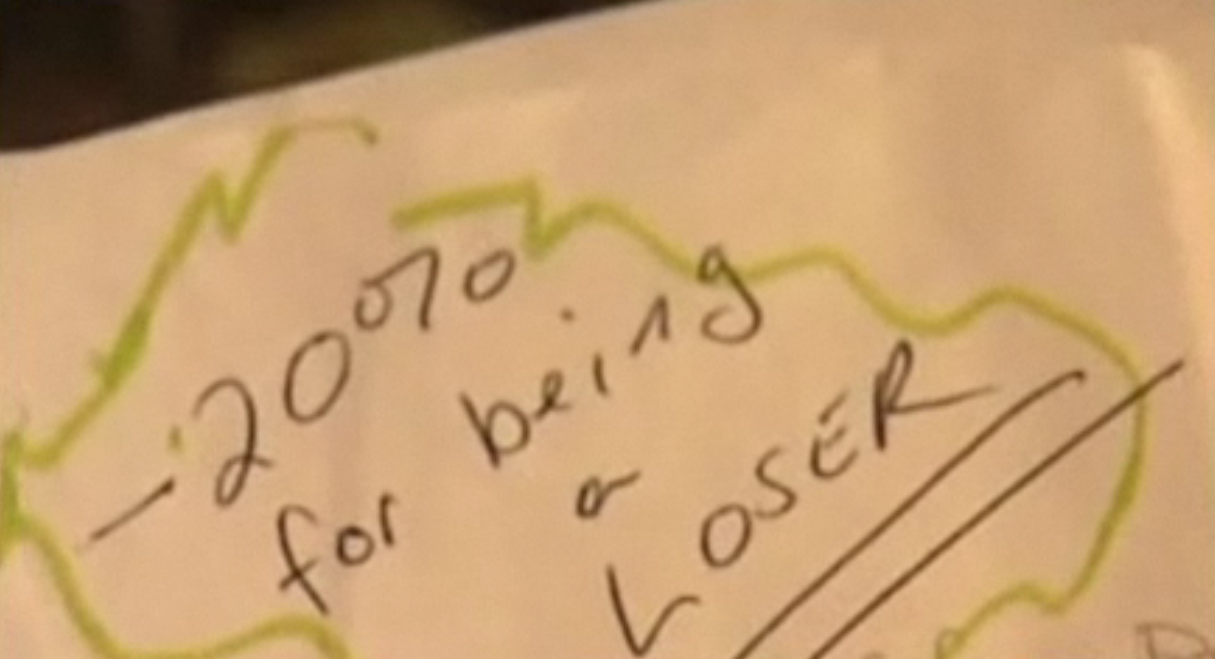
A 6th grade teacher who marked 20% off a student’s assignment “for being a loser” says he was joking, that it was some kind of informal ingratiation used to relate to the student. Herein lies the trouble with rhetoric, or purposeful irony, because intent is something earned in the reader, never intrinsic to the inception of the writing. In reading random articles’ comments about this story, I was struck by the abundance of caps. Of the passionate folk:
Excel at art
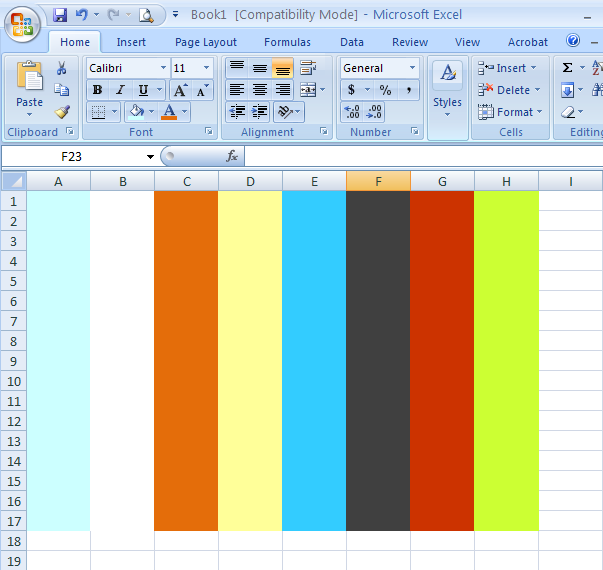
"Vimeo Waiting," Microsoft Excel, 2010
In 1963 Josef Albers published a book on color theory, and since then color — “pure” color, the mathematical hue — has been the rage in abstract painting and design. In the old (c. ’70 – ’80s) days, painters spent months covering a canvas monochrome, blending, blending away the brush marks. The human hand was a horrible thing, corrupted with subjectively. An MFA in Painting student today is still prone to sit hours in front of their canvas, lamenting over which color to juxtapose another color with, and while I respect that solemn responsibility, I prefer the quick MS excel fix, take Vimeo’s default ‘no signal’ screen.
Power Quote: “The Man”
 People try to get out of themselves and to escape from the man. This is folly; instead of transforming themselves into angels, they turn themselves into beasts; instead of lifting, they degrade themselves.
People try to get out of themselves and to escape from the man. This is folly; instead of transforming themselves into angels, they turn themselves into beasts; instead of lifting, they degrade themselves.
— Montaigne, Essays (1580)
I smiled when I read “the man,” because it was written so long ago. Seems like “the man” has been bringing us down since the 16th century, the most current manifestation being Comcast (host of my internet, cable, and landline) without whom I would only exist in vivo, and how lame is that?
Scroll down to read this
 Jack Kerouac was either stoned or zenned out when he wrote the entire manuscript of On the Road without paragraph breaks on a scroll (how he fed this through his typewriter still confuses me). Stream of consciousness is a nice conceit, one deserving to be hosted on a scroll, as long as toilet paper — the most imperative scroll of modern time — isn’t evoked. I remember reading a 1/4 way into On the Road and thinking “where is he going?” Dharma Bums was much better, especially for people in their late twenties who are living with their parents, a plight shared by the narrator.
Jack Kerouac was either stoned or zenned out when he wrote the entire manuscript of On the Road without paragraph breaks on a scroll (how he fed this through his typewriter still confuses me). Stream of consciousness is a nice conceit, one deserving to be hosted on a scroll, as long as toilet paper — the most imperative scroll of modern time — isn’t evoked. I remember reading a 1/4 way into On the Road and thinking “where is he going?” Dharma Bums was much better, especially for people in their late twenties who are living with their parents, a plight shared by the narrator.
↓
↓
↓
↓
Robert Rauschenberg’s Automobile Tire Print (1953) is a 100-ft. print of, um, a tire. He created it with John Cage, who no doubt was mumbling 4’3″ to himself while driving the car. In museums it’s displayed horizontally, mostly in part due to ceiling clearances probably, though this strikes me as a “western” way of seeing things: we read and write from left to right, and stuck on this earth without notions of above, we walk and drive horizontally. Rauschenberg is a more playful and earnest Warhol; his tire print traces the volition of our time — driving nowhere, from left to right.
↓
↓
↓
↓
↓
↓
↓
↓
↓
↓
↓
↓
↓
↓
↓
↓
↓
↓
↓
↓
↓
↓
↓
I don’t know much about the Torah, except that it’s rules of Judaism. I don’t understand why Jews are the only white people who aren’t white; what the hell happened? I once looked up a list of common Jewish surnames and was like “holy shit I know a lot of Jews!” even including girls I had crushes on. I recently learned that Jews only date Jews; where was wikipedia when I was 17?
↓
↓
Okay, let’s talk about Asians. I feel like I can freely talk about Asians because I am. Asians read up and down in columns, as it’s easier to pivot your neck up and down as supposed to left and right. I may seem biased, but Asian ways are usually more logical than western ways. If you take a Chinese character written in calligraphy and zoom in, it looks like a Franz Kline. (I had a Greek friend who would argue with me about who invented what first, the Greeks or the Chinese. Stupid ass dunno that Gorillas invented everything.) Do you know what the Chinese character for “patience” is? A knife forever suspended above a heart. The heart looks like a heart; the knife a knife. And the character for “good”? A mother next to her child. I will admit the alphabet is more useful, but Chinese breaks my heart.
↓
↓
↓
↓
↓
↓
↓
↓
↓
HTMLGIANT contributors have been instructed to insert “READ MORE >” breaks within a 1/3 of screen space out of consideration for the other posts; thus, a sort of “politics of page breaks,” where the longer it takes for a contributor to place a break, the more selfish he or she is deemed. It’s funny how so much time later, devoid of past sacred ties, we use the word “scroll” to describe the act of descending deep and deeper into a website page. Most mouse’s have a “scroll wheel” to help with our profane endeavors. My finger often gets so tired, running across the wheel blindly like a hairless guinea pig. If you’ve made it this far, I think you know what I mean. I worry about this post, for hogging so much “front page,” but I hope you understand the vertiginous verticality of this post is simply in aid to the point offered by its title.

